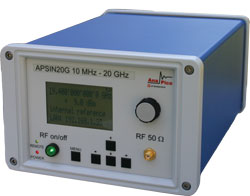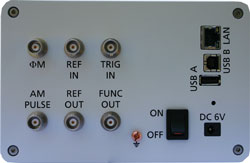
In order to provide customers with a lightweight, compact, low cost alternative to high-end laboratory-grade instruments, AnaPico has developed the APSIN signal generator product line. The latest addition is the APSIN20G, which is a portable instrument that completes the product family with an instrument that extends the frequency coverage to 20 GHz. The APSIN20G is available with an optional internal rechargeable battery that makes it suitable for applications outside the lab, without any compromise in RF performance.
The microwave signal generator's key performance characteristics are summarized in Table 1. With this instrument, users are able to benefit from leading-edge phase noise, fine frequency resolution, wide dynamic range, fast switching speeds and good analog modulation capabilities. Another key feature is ease of operation in a variety of applications, especially mobile or airborne applications, automated testing and manufacturing, military communications and radar, education and research labs and field testing.
SIGNAL PURITY
The instrument produces a signal with excellent phase noise and low spurious and harmonic content. The measured phase noise is shown in Figure 1. Single-sideband phase noise of -110 dBc/Hz at 10 GHz carrier and 20 kHz offset is measured, along with low spurious and good harmonic suppression. This makes the signal generator attractive for all applications that require spectrally pure signals.


Figure 1 Measured phase noise.
The APSIN20G's analog modulation capabilities cover AM, FM, ΦM and pulse modulation. Multiple modulations can be combined with up to three internal modulation sources available. External modulation signals are provided through the rear panel connectors that are shown in Figure 2. Wideband low-distortion DC-coupled FM, frequency chirps and user programmable pulse trains complete the instrument's key features.

Figure 2 External modulation signals are provided through the rear panel connectors.
The APSIN20G uses a temperature compensated ultra-stable 100 MHz OCXO as internal reference. This is divided up to provide a 10 MHz signal at the rear panel output. An exclusive feature, the internal reference can be programmed to phase lock to any external reference frequency from 1 to 250 MHz.
FAST SWITCHING
Today, most ATE applications require fast switching of power and frequency to maximize throughput in manufacturing and testing, and special care has be taken to minimize transients during switching from one frequency to another. With switching speeds of less than 200 μs, the APSIN20G provides a suitable solution. Even faster switching can be achieved with dedicated frequency and list sweeps.
List sweeps can be run with individual dwell time, off time and power level for each frequency. Even long lists can be loaded and executed with high timing accuracy because transients are taken into account and external triggering (via rear panel input or SCPI) allows full synchronization with the test environment.

Figure 3 Measured maximum output power vs. frequency.
In many applications (such as mixers with a high LO drive level), a high RF power is desirable to avoid complicated and costly setups with external power amplifiers. As standard, the APSIN20G provides high output power with low harmonic content. The level setting range is -90 to +13 dBm over the entire frequency range, with typical over-range greater than +15 dBm (see Figure 3).
For applications requiring a level setting range not exceeding 35 dB, the output step attenuator can be omitted. The good level accuracy and repeatability of the instrument – level uncertainty typically < 0.5 dB – provides users with temperature stabilized signal amplitudes.
REMOTE CONTROL
Another key feature of the new instrument is that its ease of use helps to ensure that lab staff and manufacturers can use it very efficiently. User-friendly features include an intuitive front panel with an LCD display and a Windows-based graphical user interface (GUI). In addition to the front-panel controls, the APSIN20G includes Ethernet VXI-11, USB-TMC, and optionally GPIB interfaces for flexibility in setting up a test system with remote control. The USB device port may be used to attach a USB-powered power meter for on-site level calibration.
Setting up the APSIN20G in an automatic-test-equipment (ATE) application is straightforward. Each signal generator is supplied with instrument drivers, programming examples, as well as graphical-user-interface software. The low power and fan-less design is ideal for applications in space-limited and thermal-constraint ATE systems. Also, an optional rack-mount kit is available to simplify integration.
HANDHELD APPLICATIONS
The internal rechargeable battery and a handy soft bag make it a truly portable instrument, which is particularly attractive for service installation and maintenance applications. At just 3 kg, the APSIN20G is light enough to be easily carried around a laboratory or production facility for spot testing. Its good performance, combined with ease-of-use and broad functionality, makes it suitable for field environments and applications that require mobility such as site surveys, on-site system test or base station receive level calibration.
The APSIN20G provides state-of-the-art performance, a complete feature set for modulation, sweeping and triggering and extra features like battery operation. There is no noisy fan and a key feature is flexible reference locking. All of which come at an affordable price.
AnaPico Ltd.,
Zurich, Switzerland
+41 44 440 00 51
sales@anapico.com
www.anapico.com
